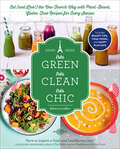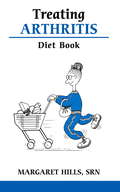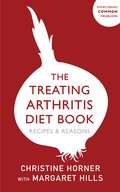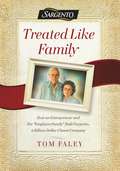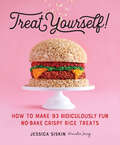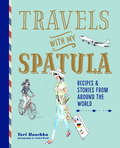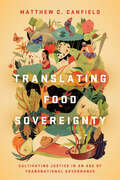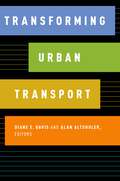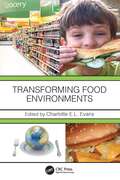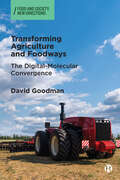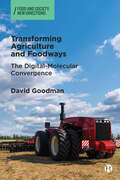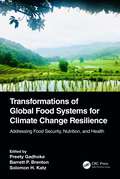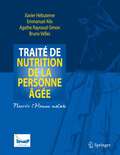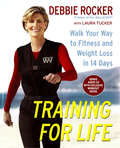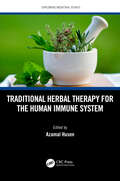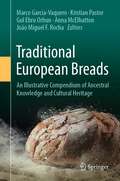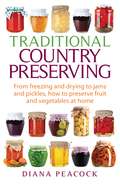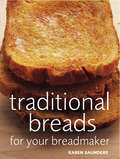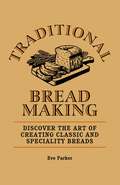- Table View
- List View
Très Green, Très Clean, Très Chic: Eat (and Live!) the New French Way with Plant-Based, Gluten-Free Recipes for Every Season
by Rebecca LefflerSay Bonjour to Green Cuisine—it&’s the new French way to be healthy, happy, and stylish, bien sûr! No one does food and lifestyle like the French! That&’s why the French approach to clean, green eating adds a dash of flair—or a drizzle of decadence—to even the humblest of fruits, veggies, and legumes. In this cheerful, charming cookbook, Rebecca Leffler shows you how they do it. She introduces her &“best friend foods&” like sweet potatoes and chia, whirlwinds through an entire rainbow of juices and smoothies, and keeps the focus on fitness, food, and fun in equal measures. Globally inspired, but with lots of French accents, all 150 plant-based recipes are free of gluten, soy, and refined sugar. Rebecca organizes them the natural way: by season. Feed your body what it needs during . . .Spring: Beet Rawvioli with Faux-mage, White Asparagus Velouté, Le &“Chic&” CakeSummer: Salade Niçoise, Cabinet Curry, &“Split&”-Second Banana Ice CreamFall: Sobeautiful Soba Salad, Beauty Bourguignon, Pancrêpes, Apple Tarte TatinWinter: Totally Wild Stuffed Squash, Amaranth Caviar, Happy Hazelnut Quinoa Bowl. Plus, enjoy Rebecca&’s mood-boosting tips year round: natural beauty treatments, illustrated yoga poses, and positive playlists to sing along with as you peel, mince, and stir. Having to choose between pleasure and health is so last season. It&’s time to say non to unhealthy foods and oui to color, flavor, variety, and smiles!
Treating Arthritis Diet Book
by Margaret HillsThis is a companion to the author's highly successful Treating Arthritis - The Drug-Free Way. It contains a wide selection of recipes especially for arthritis. These cover hors d-oeuvres, soups, fish dishes, savouries, salads, meat dishes, poultry and game, desserts and cakes and biscuits. All the recipes are simple and easy to prepare but delicious to eat! The ingredients are neither elaborate nor costly and there is plenty of variety combined with good nutrition. If you suffer from arthritis or know someone who does, if you wish to prevent arthritis or are simply interested in a healthy diet, this book is a must.
The Treating Arthritis Diet Book: Recipes and Reasons
by Margaret Hills Christine HornerFOODS TO HELP AND HEAL ARTHRITIS - EAT BETTER, FEEL BETTERHundreds of thousands of people with arthritis have been helped by the Margaret Hills Clinic and by Margaret's bestselling book, Treating Arthritis: The Drug-free Way. This companion title, completely updated with all-new recipes, offers a full range of nutritional resources to bring about an improvement for anyone struggling with pain and mobility.Embracing the simple principles that make this drug-free protocol so effective, this book offers hundreds of recipes and dietary plans, as well as an overview of why diet is so important for managing arthritis. It caters for vegetarians and vegans, and has recommendations for those managing auto-immune conditions such as coeliac disease, or food allergies. There are clean, contemporary and delicious meals for every season, as well as such essentials as smoothies, juices, bone broth and healthful bread recipes. With an emphasis on fresh, raw, local ingredients, the recipes in this book complement the Treating Arthritis programme to offer gentle, natural and manageable steps to reduce pain and improve mobility.
Treated Like Family: How An Entrepreneur And His "employee Family" Built Sargento, A Billion-dollar Cheese Company
by Tom FaleyAt the age of nineteen, high school diploma in hand, Leonard Gentine knew two things: he wanted to own a family business that would pass from generation to generation, and he wanted to spend the rest of his life with Dolores Becker, a girl he'd met on a blind date. For Leonard, life didn't prove that simple. This biography, told from the viewpoint of four generations of the Gentine family, places the reader in Leonard's shoes as he advances from young man to old age and discovers life's foundational lessons. Along the way, he endures outstanding debts, disappointments, and a collection of small businesses, all with Dolores at his side. It's an inspirational story of perseverance, personal integrity, and a mind-set of always doing the right thing-as painful as that may be in the short term. Treated Like Family details the development of Sargento-a nationally recognized cheese company and household name. At the same time, it's a timeless story that showcases the importance of the individual and how a family united in a single purpose within the right culture is unstoppable. Tom Faley invites the reader into the lives of the Gentine family and the men and women they hired, deftly weaving a story grounded in over 180 interviews-the collective voices of the company's employees, retirees, and friends. Treated Like Family offers a rare glimpse into the creative mind of an innovator and entrepreneur and underscores the rewards for all of us when we maintain our humanity toward one another: When one person motivates others to pull together, at times facing unspeakable odds, he is able not only to change their lives but to alter history.
Treat Yourself!: How to Make 93 Ridiculously Fun No-Bake Crispy Rice Treats
by Jessica Siskin93 cool and creative crowd-pleasing projects that begin with just butter, marshmallows, and crispy rice. From individual apples to a graphic zebra large enough for a party, here are 93 ridiculously fun no-bake rice treats. Just mix, shape (with help of 75 printable templates), decorate, and done! From donuts to dinosaurs—and a robot to a football stadium (to steal the show at your annual Super Bowl party)—these are easy, unique treats for birthdays, holidays, school events, and any other day that calls for dessert.
Travels with My Spatula: Recipes & stories from around the world
by Tori HaschkaTransport your kitchen on a trip around the world with this delicious collection of cultural cuisine.If you’ve ever found yourself dreaming about that time you spent sipping Margaritas in Mexico, or when you had to have just one more croquette from the mouth-watering displays of tapas in Spain, you’re not alone. Tastes, aromas and the whole foodie experience of a country can stay with you for years, and make you want to pack your bags and relive that moreish moment in time. Food and travel writer Tori Haschka felt exactly the same every time she travelled, finding herself collecting Post-It notes of memorable dishes she’d eaten and then – when she got home – she’d capture her experiences through recreating recipes.Split into chapters covering brunch, sweet treats and summer and winter recipes, you can try her slow-cooked ribs from Brooklyn, the perfect pasta from Rome or luscious lentil koshary from Cairo; each recipe is a delicious memory waiting to be brought back to life in her home and yours. Who knows, it may even inspire you to book a flight and take a foodie journey of your own!
Translating Food Sovereignty: Cultivating Justice in an Age of Transnational Governance
by Matthew C. CanfieldIn its current state, the global food system is socially and ecologically unsustainable: nearly two billion people are food insecure, and food systems are the number one contributor to climate change. While agro-industrial production is promoted as the solution to these problems, growing global "food sovereignty" movements are challenging this model by demanding local and democratic control over food systems. Translating Food Sovereignty accompanies activists based in the Pacific Northwest of the United States as they mobilize the claim of food sovereignty across local, regional, and global arenas of governance. In contrast to social movements that frame their claims through the language of human rights, food sovereignty activists are one of the first to have articulated themselves in relation to the neoliberal transnational order of networked governance. While this global regulatory framework emerged to deepen market logics, Matthew C. Canfield reveals how activists are leveraging this order to make more expansive social justice claims. This nuanced, deeply engaged ethnography illustrates how food sovereignty activists are cultivating new forms of transnational governance from the ground up.
Translating Food Sovereignty: Cultivating Justice in an Age of Transnational Governance
by Matthew C. CanfieldIn its current state, the global food system is socially and ecologically unsustainable: nearly two billion people are food insecure, and food systems are the number one contributor to climate change. While agro-industrial production is promoted as the solution to these problems, growing global "food sovereignty" movements are challenging this model by demanding local and democratic control over food systems. Translating Food Sovereignty accompanies activists based in the Pacific Northwest of the United States as they mobilize the claim of food sovereignty across local, regional, and global arenas of governance. In contrast to social movements that frame their claims through the language of human rights, food sovereignty activists are one of the first to have articulated themselves in relation to the neoliberal transnational order of networked governance. While this global regulatory framework emerged to deepen market logics, Matthew C. Canfield reveals how activists are leveraging this order to make more expansive social justice claims. This nuanced, deeply engaged ethnography illustrates how food sovereignty activists are cultivating new forms of transnational governance from the ground up.
TRANSFORMING URBAN TRANSPORT OXFMT C
by Diane E. Davis Alan AltshulerTransforming Urban Transport brings into focus the origins and implementation pathways of significant urban transport innovations that have recently been adopted in major, democratically governed world cities that are seeking to advance sustainability aims. It documents how proponents of new transportation initiatives confronted a range of administrative, environmental, fiscal, and political obstacles by using a range of leadership skills, technical resources, and negotiation capacities to move a good idea from the drawing board to implementation. The book's eight case studies focus on cities of great interest across the globe--Los Angeles, Mexico City, New York, Paris, San Francisco, Seoul, Stockholm, and Vienna--many of which are known for significant mayor leadership and efforts to rescale power from the nation to the city. The cases highlight innovations likely to be of interest to transport policy makers from all corners, such as strengthening public transportation services, vehicle and traffic management measures, repurposing roads and other urban spaces away from their initial function as vehicle travel corridors, and turning sidewalks and city streets into more pedestrian-friendly places for walking, cycling, and leisure. Aside from their transformative impacts in transportation terms, many of the policy innovations examined here have altered planning institutions, public-private sector relations, civil society commitments, and governance mandates in the course of implementation. In bringing these cases to the fore, Transforming Urban Transport advances understanding of the conditions under which policy interventions can expand institutional capacities and governance mandates, particularly linked to urban sustainability. As such, it is an essential contribution to larger debates about what it takes to make cities more environmentally sustainable and the types of strategies and tactics that best advance progress on these fronts in both the short- and the long-term.
Transforming Urban Transport
Transforming Urban Transport brings into focus the origins and implementation pathways of significant urban transport innovations that have recently been adopted in major, democratically governed world cities that are seeking to advance sustainability aims. It documents how proponents of new transportation initiatives confronted a range of administrative, environmental, fiscal, and political obstacles by using a range of leadership skills, technical resources, and negotiation capacities to move a good idea from the drawing board to implementation. The book's eight case studies focus on cities of great interest across the globe--Los Angeles, Mexico City, New York, Paris, San Francisco, Seoul, Stockholm, and Vienna--many of which are known for significant mayor leadership and efforts to rescale power from the nation to the city. The cases highlight innovations likely to be of interest to transport policy makers from all corners, such as strengthening public transportation services, vehicle and traffic management measures, repurposing roads and other urban spaces away from their initial function as vehicle travel corridors, and turning sidewalks and city streets into more pedestrian-friendly places for walking, cycling, and leisure. Aside from their transformative impacts in transportation terms, many of the policy innovations examined here have altered planning institutions, public-private sector relations, civil society commitments, and governance mandates in the course of implementation. In bringing these cases to the fore, Transforming Urban Transport advances understanding of the conditions under which policy interventions can expand institutional capacities and governance mandates, particularly linked to urban sustainability. As such, it is an essential contribution to larger debates about what it takes to make cities more environmentally sustainable and the types of strategies and tactics that best advance progress on these fronts in both the short- and the long-term.
Transforming Food Environments
by Charlotte E.L. EvansWe regularly find ourselves in food environments that promote the consumption of high fat and sugary foods rather than encouraging us to eat more fruit and vegetables. However, because of increased media attention, people are becoming more interested in alternative approaches to improving the many food-related decisions we make daily. Transforming Food Environments features evidence from several disciplines exploring initiatives that have improved food environments and discusses the importance of achieving success in equitable and sustainable ways. The book presents information on diverse food environments followed by methods that help readers become aware of the design of interventions and food policies. It covers food environments in schools, workplaces, and community centres as well as fast food establishments and food marketing. The book presents methods to help encourage better food choices and purchase of healthier foods. It explores persuasion tactics used by health professionals such as changing availability and/or price, using nudging techniques, and food labelling. Led by Editor Charlotte Evans, Associate Professor of Nutritional Epidemiology and Public Health Nutrition at the University of Leeds; and written by an international range of authors from countries including the US, Canada, Australia, New Zealand, Japan and the United Kingdom, this multidisciplinary book appeals to students, researchers, public health professionals and policy makers. It also raises awareness and provides a comprehensive treatment of the importance of our environments on food choice.
Transforming Food Environments
by Charlotte El EvansWe regularly find ourselves in food environments that promote the consumption of high fat and sugary foods rather than encouraging us to eat more fruit and vegetables. However, because of increased media attention, people are becoming more interested in alternative approaches to improving the many food-related decisions we make daily. Transforming Food Environments features evidence from several disciplines exploring initiatives that have improved food environments and discusses the importance of achieving success in equitable and sustainable ways. The book presents information on diverse food environments followed by methods that help readers become aware of the design of interventions and food policies. It covers food environments in schools, workplaces, and community centres as well as fast food establishments and food marketing. The book presents methods to help encourage better food choices and purchase of healthier foods. It explores persuasion tactics used by health professionals such as changing availability and/or price, using nudging techniques, and food labelling. Led by Editor Charlotte Evans, Associate Professor of Nutritional Epidemiology and Public Health Nutrition at the University of Leeds; and written by an international range of authors from countries including the US, Canada, Australia, New Zealand, Japan and the United Kingdom, this multidisciplinary book appeals to students, researchers, public health professionals and policy makers. It also raises awareness and provides a comprehensive treatment of the importance of our environments on food choice.
Transforming Agriculture and Foodways: The Digital-Molecular Convergence
by David GoodmanA wave of innovation driven by the convergence of digital and molecular technologies is transforming food production and ways of eating in the US, Western Europe and Australasia. This book explores a range of contemporary agri-food issues, such as the digitalisation of farm production, aka Precision Agriculture, farmer independence, gene editing, alternative proteins and the rise of app-based home food deliveries. This is the first book to provide a systemic analysis of technological innovation and its socio-economic consequences in modern food systems, including the ‘hollowing out’ of rural communities and pronounced industrial concentration. The food system is under growing public pressure to respond to global climate change, but this book finds little evidence of transition to sustainable low-carbon trajectories.
Transforming Agriculture and Foodways: The Digital-Molecular Convergence
by David GoodmanA wave of innovation driven by the convergence of digital and molecular technologies is transforming food production and ways of eating in the US, Western Europe and Australasia. This book explores a range of contemporary agri-food issues, such as the digitalisation of farm production, aka Precision Agriculture, farmer independence, gene editing, alternative proteins and the rise of app-based home food deliveries. This is the first book to provide a systemic analysis of technological innovation and its socio-economic consequences in modern food systems, including the ‘hollowing out’ of rural communities and pronounced industrial concentration. The food system is under growing public pressure to respond to global climate change, but this book finds little evidence of transition to sustainable low-carbon trajectories.
Transformations of Global Food Systems for Climate Change Resilience: Addressing Food Security, Nutrition, and Health
by Preety Gadhoke Barrett P. Brenton Solomon H. KatzTransformations of Global Food Systems for Climate Change Resilience: Addressing Food Security, Nutrition, and Health provides poignant case studies of climate change resilience frameworks for nutrition-focused transformations of agriculture and food systems, food security, food sovereignty, and population health of underserved and marginalized communities from across the globe. Each chapter is drawn from diverse cultural contexts and geographic areas, addressing local challenges of ongoing food and health system transformations and illustrating forms of resistance, resilience, and adaptations of food systems to climate change. Fourteen chapters present global case studies, which directly address the United Nations Sustainable Development Goals and the Food and Agriculture Organization’s global call to action for transforming agriculture, addressing food security and nutrition, and the health of populations impacted by climate change and public health issues.They also integrate reflections, insights, and experiences resulting from the COVID-19 Pandemic. This edited volume includes research on (1) enhancing food sovereignty and food security for underserved populations with a particular focus on indigenous peoples; (2) improving locally contextualized definitions and measurements of climate change resilience, food security, hunger, nutrition, and health; (3) informing public health programs and policies for population health and nutrition; and (4) facilitating public and policy discourse on sustainable futures for community health and nutrition in the face of climate change and natural disasters, including ongoing and future pandemics or emergencies. Within this book, readers discover an array of approaches by the authors that exemplify the mutually engaged and reciprocal partnerships that are community-driven and support the positive transformation of the people with whom they work. By doing so, this book informs and drives a global sustainable future of scholarship and policy that is tied to the intersectionality and synergisms of climate change resilience, food security, food sovereignty, nutrition, and community health.
Transformations of Global Food Systems for Climate Change Resilience: Addressing Food Security, Nutrition, and Health
Transformations of Global Food Systems for Climate Change Resilience: Addressing Food Security, Nutrition, and Health provides poignant case studies of climate change resilience frameworks for nutrition-focused transformations of agriculture and food systems, food security, food sovereignty, and population health of underserved and marginalized communities from across the globe. Each chapter is drawn from diverse cultural contexts and geographic areas, addressing local challenges of ongoing food and health system transformations and illustrating forms of resistance, resilience, and adaptations of food systems to climate change. Fourteen chapters present global case studies, which directly address the United Nations Sustainable Development Goals and the Food and Agriculture Organization’s global call to action for transforming agriculture, addressing food security and nutrition, and the health of populations impacted by climate change and public health issues.They also integrate reflections, insights, and experiences resulting from the COVID-19 Pandemic. This edited volume includes research on (1) enhancing food sovereignty and food security for underserved populations with a particular focus on indigenous peoples; (2) improving locally contextualized definitions and measurements of climate change resilience, food security, hunger, nutrition, and health; (3) informing public health programs and policies for population health and nutrition; and (4) facilitating public and policy discourse on sustainable futures for community health and nutrition in the face of climate change and natural disasters, including ongoing and future pandemics or emergencies. Within this book, readers discover an array of approaches by the authors that exemplify the mutually engaged and reciprocal partnerships that are community-driven and support the positive transformation of the people with whom they work. By doing so, this book informs and drives a global sustainable future of scholarship and policy that is tied to the intersectionality and synergisms of climate change resilience, food security, food sovereignty, nutrition, and community health.
Transform Your Body With Weights: Complete Workout and Meal Plans From Beginner to Advanced
by Chloe MadeleyHave you ever wanted to add weights into your exercise routine but not known where to start? Or perhaps you already lift weights but want to know how to achieve a different aesthetic result? In Transform Your Body with Weights, Chloe Madeley tells you everything you need to know in order to weight-train correctly and effectively.She provides three different exercise and nutrition plans to choose from depending on whether you want to lose fat, gain muscle or increase your strength. Whether you are a beginner, intermediate or advanced, Chloe will guide you through the appropriate exercises for your level. With fully illustrated, day-by-day exercise instructions and a comprehensive food bible with recipes, everything you need to know to start your weight-lifting journey is in these pages.
Traité de nutrition de la personne âgée: Nourrir L'homme Malade
by Xavier Hébuterne Emmanuel Alix Agathe Raynaud-Simon Bruno VellasCe traité réunit près de 50 scientifiques francophones rassemblés autour de la SFNEP, parmi lesquels des médecins, pharmaciens, chercheurs ou diététiciens qui font autorité dans le domaine de la nutrition et du métabolisme de la personne âgée. Les modifications des grands métabolismes, l’obésité de la personne âgée ainsi que le diagnostic et la prise en charge forment les trois parties de cet ouvrage. Véritable outil de référence, d’enseignement et de formation, il permettra au lecteur d’actualiser ses connaissances sur des sujets comme la sarcopénie, les relations entre la nutrition et les fonctions cognitives, la prise en charge nutritionnelle du patient atteint de la maladie d’Alzheimer ou d’une affection néoplasique. Certains chapitres font le point sur les derniers domaines de la recherche et d’autres, permettront une conduite de la prise en charge nutritionnelle (en ambulatoire, à l’hôpital ou en institutions) selon les recommandations les plus récentes.
Training for Life: Walk Your Way to Fitness and Weight Loss in 14 Days
by Debbie Rocker Laura TuckerIn this engaging, easy-to-follow fitness book, celebrity fitness trainer Debbie Rocker shows readers how to use walking -- the body's most natural form of exercise -- to achieve total transformation in a mere two weeks.Celebrity fitness trainer Debbie Rocker is one of the original developers of Spinning, the international fitness phenomenon, and a world record holder in cycling. In Training for Life, she presents her personalized fitness philosophy in a 14-day program that includes walking basics, dietary recommendations, and additional upper body workouts that tone muscles, build bone density, and speed weight loss.Readers will discover how they can build confidence, attain total fitness, and train their minds to think of exercise and proper nutrition as fulfilling parts of life.
Traditional Herbal Therapy for the Human Immune System (Exploring Medicinal Plants)
by Azamal HusenDrawing on indigenous and scientific knowledge of medicinal plants, Traditional Herbal Therapy for the Human Immune System presents the protective and therapeutic potential of plant-based drinks, supplements, nutraceuticals, synergy food, superfoods, and other products. Medicinal plants and their products can affect the immune system and act as immunomodulators. Medicinal plants are popularly used in folk medicine to accelerate the human immune defence and improve body reactions against infectious or exogenous injuries, as well as to suppress the abnormal immune response occurring in immune disorders. This book explains how medicinal plants can act as a source of vitamins and improve body functions such as enhanced oxygen circulation, maintained blood pressure and improved mood. It also outlines how specific properties of certain plants can help boost the immune system of humans with cancer, HIV, and COVID-19. Key features: Provides specific information on how to accelerate and or fortify the human immune system by using medicinal plants. Presents scientific understanding of herbs, shrubs, climbers and trees and their potential uses in conventional and herbal medicine systems. Discusses the specific role of herbal plants that act as antiviral and antibacterial agents and offer boosted immunity for cancer, H1N1 virus, relieving swine flu, HIV and COVID-19 patients. Part of the Exploring Medicinal Plants series, this book is useful for researchers and students, as well as policy makers and people working in industry, who have an interest in plant-derived medications.
Traditional Herbal Therapy for the Human Immune System (Exploring Medicinal Plants)
by Azamal HusenDrawing on indigenous and scientific knowledge of medicinal plants, Traditional Herbal Therapy for the Human Immune System presents the protective and therapeutic potential of plant-based drinks, supplements, nutraceuticals, synergy food, superfoods, and other products. Medicinal plants and their products can affect the immune system and act as immunomodulators. Medicinal plants are popularly used in folk medicine to accelerate the human immune defence and improve body reactions against infectious or exogenous injuries, as well as to suppress the abnormal immune response occurring in immune disorders. This book explains how medicinal plants can act as a source of vitamins and improve body functions such as enhanced oxygen circulation, maintained blood pressure and improved mood. It also outlines how specific properties of certain plants can help boost the immune system of humans with cancer, HIV, and COVID-19. Key features: Provides specific information on how to accelerate and or fortify the human immune system by using medicinal plants. Presents scientific understanding of herbs, shrubs, climbers and trees and their potential uses in conventional and herbal medicine systems. Discusses the specific role of herbal plants that act as antiviral and antibacterial agents and offer boosted immunity for cancer, H1N1 virus, relieving swine flu, HIV and COVID-19 patients. Part of the Exploring Medicinal Plants series, this book is useful for researchers and students, as well as policy makers and people working in industry, who have an interest in plant-derived medications.
Traditional European Breads: An Illustrative Compendium of Ancestral Knowledge and Cultural Heritage
by Marco Garcia-Vaquero Kristian Pastor Gul Ebru Orhun Anna McElhatton João Miguel F. RochaThis text comprehensively covers the rituals, traditions and receipts of ancestral processes of bread making from multiple countries, including the scientific and technological character of the science of bread making and sourdough biotechnology. Individual chapters cover the scientific aspects of bread making in different cultures and traditions as well as the technological phenomena occurring during the bread making process, utilizing the full network of SOURDOMICS from the COST initiative.Pictures and illustrations are used to explain the science behind bread making processes and the cultural, historical and traditional elements associated with bread making in multiple countries. Authored by bread making experts from the breadth of Europe, the process of bread fermentation in each country and region is covered in detail. The traditions surrounding bread making are simply the empirical know-how passed between generations, and this book's main purpose is to perpetuate these traditions and know-how.Provides a description of the culture of European peoples with respect to the technology of bread making and sourdough biotechnology;Explains the process of bread fermentation using simple language combined with scientific rigor;High quality pictures and illustrations enrich the scientific and cultural elements mentioned in each chapter.
Traditional Country Preserving: From freezing and drying to jams and pickles, how to preserve fruit and vegetables at home
by Diana PeacockThis book will show you how to preserve our wonderful spring, summer and autumn harvests, so that you can enjoy nature’s bounty even in the sparser months. From drying, bottling and freezing to simple jams, jellies, curds, cheeses, relishes, syrups and chutneys, all you will ever need to know is explained simply and clearly in this comprehensive guide to home preserving.
Traditional Breads For Your Breadmaker
by Karen SaundersThis book is an exciting fusion of old and new - the recipes for the best traditional breads from across the UK for the very contemporary kitchen machine, the breadmaker. It picks up on the current growing interest in fresh, local produce enabling you to make great regional breads with delicious local specialities. And breadmakers grow ever more popular: there are more than two million in the UK alone, with inexpensive models that everyone can afford becoming increasingly widely available. Traditional British Breads For Your Breadmaker is aimed at novice and expert bakers alike and, for the first time, presents both favourite and lesser known traditional British recipes for breadmaker cooking. Featuring classic favourites (Sally Lunn Buns, Scottish Bannocks, Welsh Pikelets, Grasmere Gingerbread, Irish Soda Farls) and almost-forgotten delicacies (Crempog - a kind of Welsh pancake, Kentish Huffins, Bury Black Pudding Cake). In addition, Karen has created new recipes using traditional regional ingredients such as tayberries from Scotland in Oat and Tayberry Breakfast Buns and Knockamore Cheese from Ireland in Guinness and Knockamore Bread. Karen's unique collection of recipes is the must-have breadmaker cookbook.
Traditional Breadmaking: Discover the Art of Creating Classic and Speciality Breads
by Eve ParkerDiscover the art of creating classic and speciality breads with this book, which contains a collection of recipes for all-year-round comfort food.
